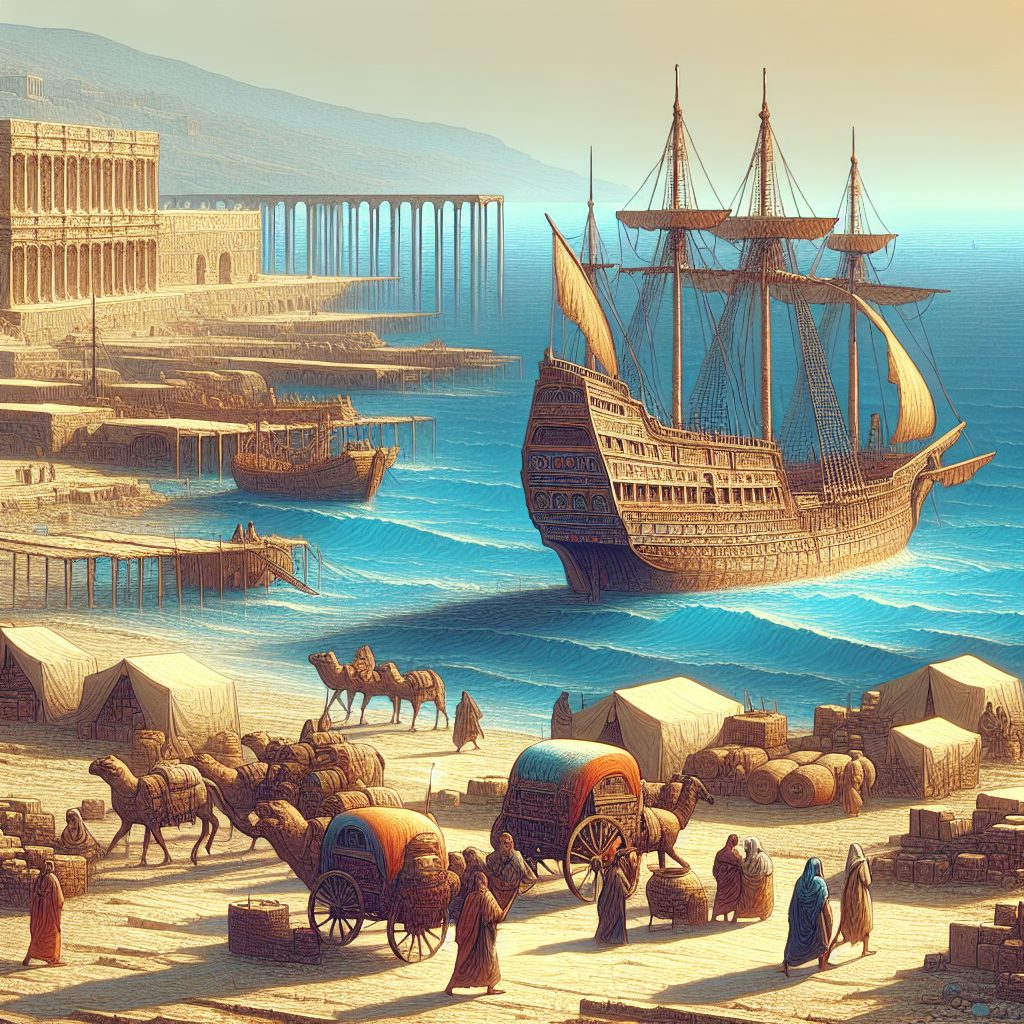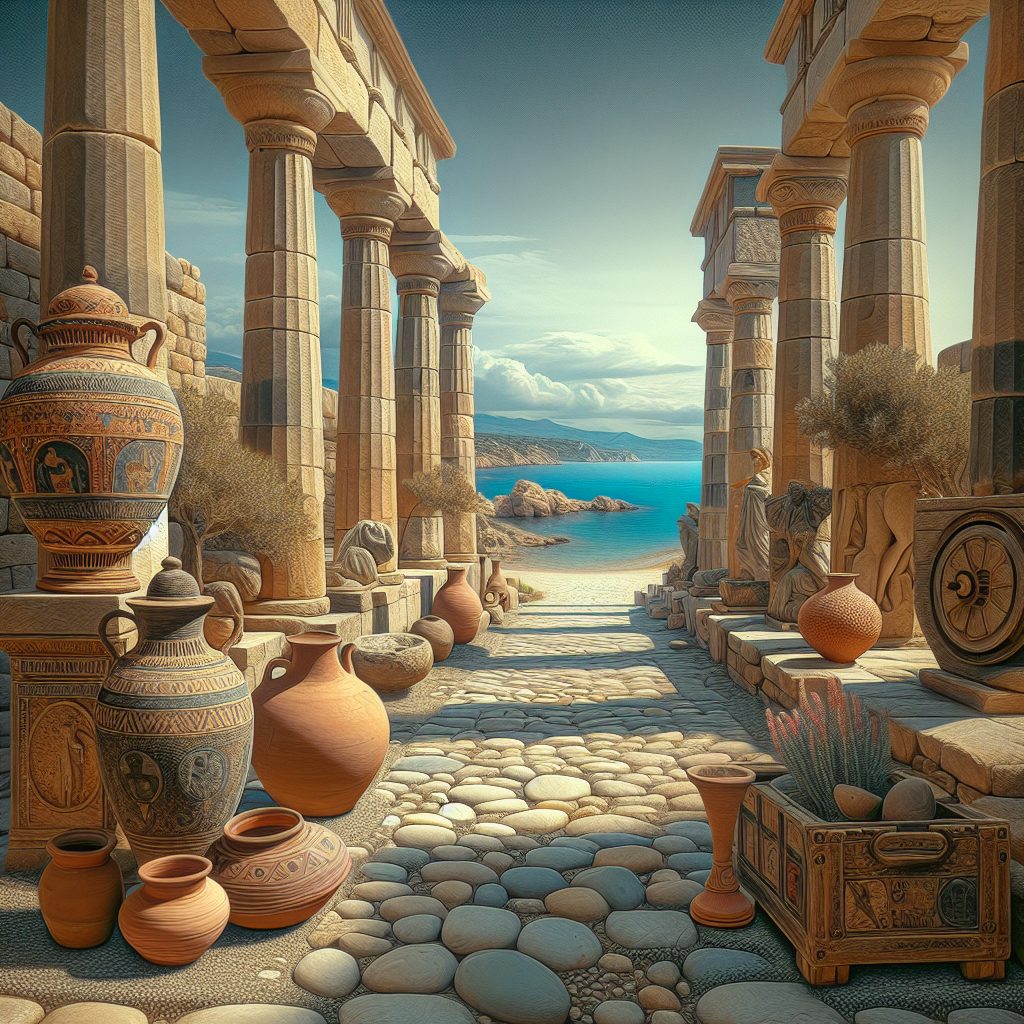Tharros, an ancient city located on the western coast of Sardinia, Italy, holds valuable insights into the fascinating trade routes that once flourished in this Mediterranean region. Dating back to the 8th century BCE, Tharros served as a strategic hub for commerce and cultural exchange, connecting civilizations from across the ancient world. This archaeological site is not only a testament to the economic significance of trade but also provides evidence of the diverse influences that shaped the region’s history.
One of the unique features of Tharros is its strategic location, positioned conveniently between Europe, Africa, and the Eastern Mediterranean. This advantageous placement made it a crucial entry point for goods and ideas flowing through these ancient trade routes. Merchants from Phoenicia, Carthage, Egypt, Greece, Rome, and other civilizations frequented the city, exchanging commodities such as metals, textiles, ceramics, precious stones, and even slaves. Tharros became a melting pot of cultures, where diverse traditions and languages intertwined, leaving indelible marks on the city’s architecture, art, and society.
Now, let us delve into the key takeaways that shed light on the significance of Tharros in understanding the ancient trade routes of the Mediterranean. Exploring the remnants of this once-thriving coastal city unravels a tapestry of interconnected commerce, cultural exchange, and the lasting impact of diverse civilizations. By examining the artifacts, inscriptions, and architectural remains found within the city’s archaeological site, we can gain valuable insights into the depth and breadth of trade networks that spanned the ancient world. Join us as we embark on a journey through time, uncovering the secrets of Tharros and the fascinating stories embedded within its ancient trade routes.
Key Takeaways
1. Tharros, an ancient Phoenician city located in Sardinia, played a crucial role as a trading hub in the Mediterranean region during the 8th to 5th centuries BCE, connecting various cultures and exchange networks.
2. Tharros was strategically positioned on the western coast of Sardinia, providing easy access to both the Tyrrhenian and the Mediterranean Seas, enabling maritime trade with neighboring regions such as Etruria, Phoenicia, and Carthage.
3. The city’s importance as a trade center is evidenced by the discovery of a diverse range of artifacts, particularly amphorae (ceramic storage jars), from different parts of the Mediterranean, indicating the extensive trade connections of Tharros with other coastal communities.
4. The economy of Tharros thrived on the export of local products, such as Sardinian grain and minerals, in exchange for imported goods, including luxury items like ceramics, metals, and precious fabrics, highlighting the cosmopolitan nature of the city.
5. Through its bustling trade activities, Tharros not only facilitated economic exchanges but also facilitated the transfer of ideas, cultural influences, and technological advancements between the civilizations it interacted with, contributing to the cultural development of both Tharros and the wider Mediterranean region.
What were the Trade Routes in Ancient Tharros?
Historical Background
The ancient city of Tharros, located on the west coast of Sardinia, played a significant role in the trade networks of the Mediterranean during ancient times. Established by the Phoenicians around the 8th century BCE, Tharros flourished as a prominent center for maritime trade.
Maritime Trade Routes
Tharros served as a vital node in the maritime trade routes that connected various civilizations in the Mediterranean. Ships from Tharros sailed to other Phoenician colonies, such as Carthage and Gadir, establishing a strong network in the region. These routes also connected Tharros with other important trade centers like Rome, Egypt, and Greece.
Overland Trade Routes
In addition to its maritime trade, Tharros also had connections through overland routes that extended into the interior of Sardinia. These connections facilitated the exchange of goods, primarily minerals and agricultural products, with other settlements on the island.
Trade Goods
The trade routes in ancient Tharros facilitated the exchange of various goods between different regions. The city was known for its production of valuable commodities such as pottery, ceramics, textiles, and metalwork. These goods, along with crops and minerals, were traded both locally and internationally.
Impact on Tharros
The trade routes had a significant impact on the growth and prosperity of Tharros. The city’s strategic location on the coast and its efficient trade networks allowed it to accumulate wealth and develop as a cultural and economic center. The influx of different goods and cultural influences contributed to the city’s diversity and enriched its artistic and architectural heritage.
Decline of the Trade Routes
The trade routes of Tharros experienced a decline in the later centuries due to various factors. The decline of the Phoenician and Carthaginian influence in the region, along with the rise of other trade centers, led to a shifting of trade routes away from Tharros. Additionally, political instability and conflicts disrupted the trade networks, causing a decline in economic activities in the city.
Tips for Exploring Tharros Trade Routes
- Visit the archaeological site of Tharros to witness the remnants of the ancient trade routes firsthand.
- Engage in guided tours to learn about the history and significance of Tharros in the ancient trade networks.
- Explore the nearby coastline to understand the importance of maritime trade in the region.
- Visit the local museums and exhibitions to see the artifacts and goods that were part of the ancient trade routes.
- Research and study the ancient civilizations that were connected through Tharros to gain a deeper understanding of the trade networks.
- Participate in workshops or cultural events that showcase the traditional skills and craftsmanship associated with the trade routes.
Frequently Asked Questions
1. What were the main trade routes connected to Tharros?
The main trade routes connected to Tharros were the Mediterranean Sea trade routes, which linked the city to other significant trading hubs in the region.
2. When did Tharros participate in ancient trade?
Tharros actively participated in ancient trade from approximately the 8th century BC until the decline of the Roman Empire in the 5th century AD.
3. What were the primary goods traded in Tharros?
The primary goods traded in Tharros included agricultural products such as wheat, barley, olives, and grapes, along with fish, salt, textiles, and pottery.
4. Were luxury goods traded in Tharros?
Yes, luxury goods like fine ceramics, precious metals, jewelry, glassware, and spices were also traded in Tharros, showcasing the city’s importance as a trading center.
5. Did Tharros have trade connections with other ancient civilizations?
Absolutely! Tharros had trade connections with various ancient civilizations, including the Phoenicians, Etruscans, Carthaginians, Greeks, and Romans.
6. How did Tharros benefit from its location?
Tharros benefited greatly from its strategic coastal location, which allowed it to become a significant trading port and provided access to a wide range of goods and trading opportunities.
7. Did Tharros have its own currency?
Yes, Tharros minted its own currency, known as the Tharrosian drachma. This currency was widely used in local and regional trade transactions.
8. What archaeological evidence supports Tharros’ importance as a trade center?
Archaeological evidence, such as the discovery of warehouses, trading goods, amphorae, and ancient coins, supports Tharros’ significance as a thriving ancient trade center.
9. How did trade impact Tharros’ economy?
Trade played a crucial role in Tharros’ economy, contributing to the city’s prosperity, growth, and wealth accumulation. It facilitated cultural exchange and brought economic opportunities to its residents.
10. What led to the decline of Tharros as a trading center?
The decline of Tharros as a trading center can be attributed to various factors, including political instability, shifting trade routes, natural disasters, and invasions by foreign powers.
Final Thoughts
Tharros ancient trade routes were not only essential for the city’s economic development and prosperity but also played a significant role in connecting civilizations and promoting cultural exchange. The archaeological findings and historical records highlight Tharros’ position as a thriving trade hub, actively engaging with various ancient societies and contributing to the growth and wealth of its inhabitants. Exploring the trade routes of Tharros allows us to delve into the fascinating history of ancient commerce and grasp the profound impact it had on the development of societies.
While Tharros may have experienced a decline as a trading center over time, its legacy as a vibrant trade hub continues to intrigue historians, archaeologists, and enthusiasts. The examination of its ancient trade routes provides valuable insights into the interconnectedness of civilizations and the importance of maritime trade in the ancient world. Tharros stands as a testament to the enduring influence that trade had on shaping the course of history, fostering connections, and driving economic growth in ancient times.






